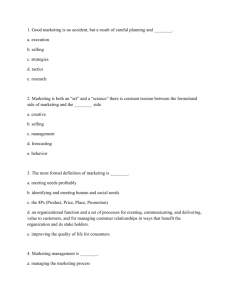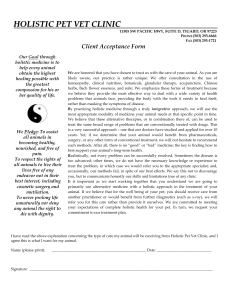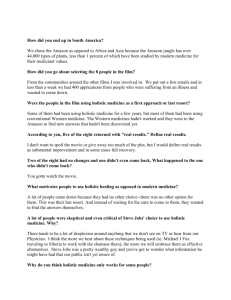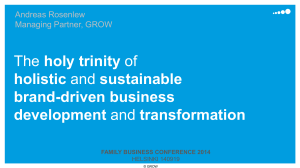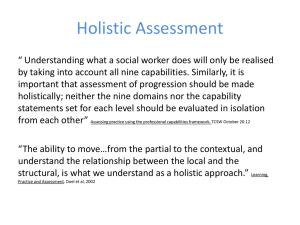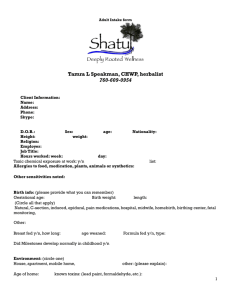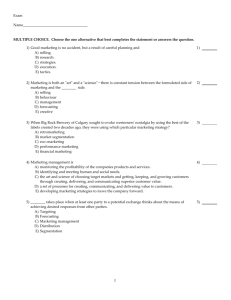1. Good marketing is no accident, but a result of careful
advertisement
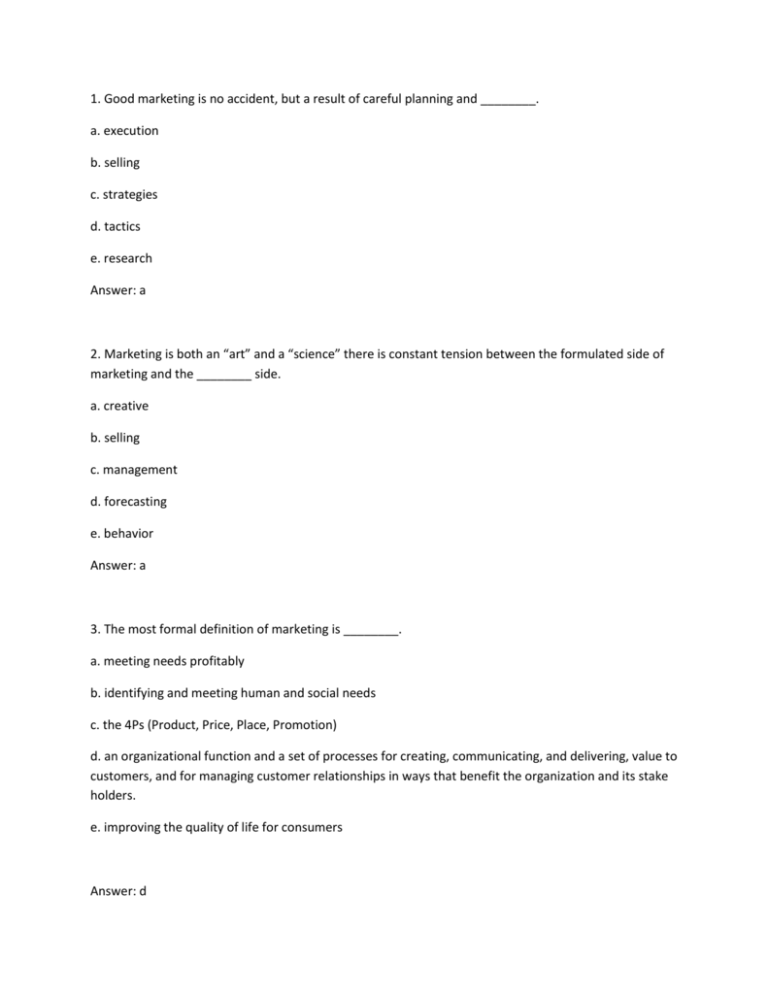
1. Good marketing is no accident, but a result of careful planning and ________. a. execution b. selling c. strategies d. tactics e. research Answer: a 2. Marketing is both an “art” and a “science” there is constant tension between the formulated side of marketing and the ________ side. a. creative b. selling c. management d. forecasting e. behavior Answer: a 3. The most formal definition of marketing is ________. a. meeting needs profitably b. identifying and meeting human and social needs c. the 4Ps (Product, Price, Place, Promotion) d. an organizational function and a set of processes for creating, communicating, and delivering, value to customers, and for managing customer relationships in ways that benefit the organization and its stake holders. e. improving the quality of life for consumers Answer: d 4. Marketing management is ________. a. managing the marketing process b. monitoring the profitability of the companies products and services c. selecting target markets d. developing marketing strategies to move the company forward e. the art and science of choosing target markets and getting, keeping, and growing customers through creating, delivering, and communicating superior customer value Answer: e 5. A transaction involves ________. a. at least two parties b. each party has something that might be of value to the other party c. each party is capable of communication and delivery d. each party is free to accept or reject the exchange offer e. all of the above Answer: e 6. ________ can be produced and marketed as a product. a. Information b. Celebrities c. Durable goods d. Organizations e. Properties Answer: a 7. Charles Revson of Revlon observed: “In the factory, we make cosmetics; in the store, ________.” a. we make profits b. we challenge competitors c. we implement ads d. we sell hope e. we sell quality Answer: d 8. A ________ is someone seeking a response (attention, a purchase, a vote, a donation) from another party, called the ________. a. salesperson, customer b. fund raiser, contributor c. politician, voter d. marketer, prospect e. celebrity, audience Answer: d 9. In ________ consumers may share a strong need that cannot be satisfied by an existing product. a. negative demand b. latent demand c. declining demand d. irregular demand e. non-existent demand Answer: b 10. In ________more customers would like to buy the product than can be satisfied. a. latent demand b. irregular demand c. overfull demand d. excessive e. negative demand Answer: c 11. Marketers often use the term ________ to cover various groupings of customers. a. people b. buying power c. demographic segment d. social class position e. market Answer: e 12. Companies selling mass consumer goods and services such as soft drinks, cosmetics, air travel, and athletic shoes and equipment spend a great deal of time trying to establish a superior brand image in markets called ________. a. business markets b. global markets c. consumer markets d. nonprofit and governmental markets e. service markets Answer: c 13. In business markets, advertising can play a role, but a stronger role may be played by the sales force, ______, and the company’s reputation for reliability and quality. a. brand image b. distribution c. promotion d. price e. performance Answer: d 14. Global marketers must decide ________. a. which countries to enter b. how to enter each country (as an exporter, licenser, joint venture partner, contract manufacturer, or solo manufacturer) c. how to adapt their product and service features to each country d. how to price their products in different countries e. all of the above Answer: e 15. Mohan Sawhney has proposed the concept of ________ to describe a cluster of complementary products and services that are closely related in the minds of consumers but are spread across a diverse set of industries. a. metamarket b. vertical integration c. horizontal integration d. betamarket e. synchronized marketing Answer: a 16. The ________ promises to lead to more accurate levels of production, more targeted communications, and more relevant pricing. a. Age of Globalization b. Age of Deregulation c. Industrial Age d. Information Age e. Production Age Answer: d 17. Many countries have ________ industries to create greater competition and growth opportunities. a. open-market b. deregulated c. regulated d. scientifically segmented e. created mass market Answer: b 18. Customers are showing greater price sensitivity in their search for ________. a. the right product b. the right service c. the right store d. value e. relationships Answer: d 19. Rising promotion costs and shrinking profit margins are the result of ________. a. changing technology b. globalization c. deregulation d. privatization e. heightened competition Answer: e 20. Industry boundaries are blurring at an incredible rate as companies are recognizing that new opportunities lie at the intersection of two or more industries this is called ________. a. globalization b. customization c. industry convergence d. heightened competition e. acquisition Answer: c 21. In response to threats from such companies as AOL, Amazon, Yahoo, eBay, E’TRADE, and dozens of others, established manufacturers and retailers became “brick-and-click” oriented by adding online services to their existing offerings. This process became known as ________. a. reintermediation b. disintermediation c. e-commerce d. e-collaboration e. new market synchronization Answer: a 22. Many brick-and-click competitors became stronger contenders in the marketplace than the pureclick firms because they had a larger pool of resources to work with and ________. a. better prices b. greater value c. well-established brand names d. one-on-one communications e. direct selling capability Answer: c 23. The ________ is practiced most aggressively with unsought goods, goods that buyers normally do not think of buying, such as insurance, encyclopedias, and funeral plots. a. marketing concept b. selling concept c. production concept d. product concept e. holistic marketing concept Answer: b 24. The ________ concept holds that consumers will favor those products that offer the most quality, performance, or innovative features. a. product b. marketing c. production d. selling e. holistic marketing Answer: a 25. The ________ concept holds that consumers and businesses, if left alone, will ordinarily not buy enough of the organization’s products. a. production b. selling c. marketing d. product e. holistic marketing Answer: b 26. Several scholars have found that companies who embrace the marketing concept achieve superior performance. This was first demonstrated for companies practicing a ________ understanding and meeting customers’ expressed needs. a. reactive market orientation b. proactive marketing orientation c. total market orientation d. impulsive market orientation e. holistic market orientation Answer: a 27. According to Theodore Levitt, who drew a perceptive contrast between the selling and marketing concepts, ________ is preoccupied with the need to convert products into cash. a. marketing b. selling c. direct marketing d. holistic marketing e. service marketing Answer: b 28. In the course of converting to a marketing orientation, a company faces three hurdles _______. a. organized resistance, slow learning, and fast forgetting b. management, customer reaction, competitive response c. decreased profits, increased R&D, additional distribution d. forecasted demand, increased sales expense, increased inventory costs e. customer focus, profitability, slow learning Answer: a 29. Companies that practice both a reactive and proactive marketing orientation are implementing a ________ and are likely to be the most successful. a. total market orientation b. external focus c. customer focus d. competitive, customer focus e. confrontation process Answer: a 30. Marketers argue for a ________ in which all functions work together to respond to, serve, and satisfy the customer. a. cross-functional team orientation b. collaboration model c. customer orientation d. management-driven organization e. total quality model Answer: c 31. ________ can be seen as the development, design, and implementation of marketing programs, processes, and activities that recognizes the breadth and interdependencies of their effects. a. Niche marketing b. Holistic marketing c. Relationship marketing d. Supply-chain marketing e. Demand-centered marketing Answer: b 32. ________ marketing has the aim of building mutually satisfying long-term relations with key parties such as customers, suppliers, distributors, and other marketing partners in order to earn and retain their business. a. Holistic b. Demand-based c. Direct d. Relationship e. Synthetic Answer: d 33. Companies who form a ________ collect information on each customer’s past transactions, demographics, psychographics, and media and distribution preferences. a. sales network b. holistic union c. marketing network d. supply-chain network e. integrated network Answer: c 34. The ability of a company to deal with customers one at a time has become practical as a result of advances in ________, computers, the Internet, and database marketing software. a. improved communication flow b. information technology c. just-in-time manufacturing d. factory customization e. customer-centered strategies Answer: d 35. One traditional depiction of marketing activities is in terms of the marketing mix or four Ps. The four Ps are characterized as being ________. a. product, positioning, place, and price b. product, production, price, and place c. promotion, place, positioning, and price d. place, promotion, production, and positioning e. product, price, promotion, and place Answer: e 36. The four Ps represent the sellers’ view of the marketing tools available for influencing buyers. From a buyer’s point of view, each marketing tool is designed to deliver a customer benefit. Robert Lauterborn suggested that the sellers’ four Ps correspond to the customers’ four Cs. The four Cs are ________. a. customer focus, cost, convenience, and communication b. customer solution, customer cost, convenience, and communication c. convenience, control, competition, and cost d. competition, cost, convenience, and communication e. category control, cost, concept development, and competition Answer: b 37. Holistic marketing incorporates ________, ensuring that everyone in the organization embraces appropriate marketing principles, especially senior management. a. profit objectives b. share of customer c. internal marketing d. the marketing mix e. strategic planning Answer: c 38. Marketing is not a department so much as a ________. a. company orientation b. philosophy c. function d. branch of management e. branch of economics Answer: a 39. Holistic marketing incorporates ________ and understanding broader concerns and the ethical, environmental, legal, and social context of marketing activities and programs. a. safe product design b. cultural marketing c. social responsibility marketing d. cross-functional teams e. direct sales policies Answer: c 40. The ________ holds that the organization’s task is to determine the needs, wants, and interests of target markets and to deliver the desired satisfactions more effectively and efficiently than competitors in a way that preserves or enhances the consumer’s and the society’s well-being. a. customer-centered business b. focused business model c. societal marketing concept d. ethically responsible marketing manager e. production-centered business Answer: c 41. Companies see ________ as an opportunity to enhance their corporate reputation, raise brand awareness, increase customer loyalty, build sales, and increase press coverage. a. cause-related marketing b. brand marketing c. equity marketing d. direct marketing e. recognition marketing Answer: a 42. When a customer has a(n) ________ need he/she wants a car whose operating cost, not its initial price, is low. a. stated b. real c. unstated d. delight e. secret Answer: b 43. When a customer has a(n) ________ need the customer wants to be seen by friends as a savvy consumer. a. real b. unstated c. delight d. secret e. stated Answer: d 44. During market segmentation analysis, the marketer identifies which segments present the greatest opportunity. These segments are called ________. a. target markets b. primary markets c. tertiary markets d. demographic markets e. focused markets Answer: a 45. For each target market, the firm develops a ________. The offering is positioned in the minds of the target buyers as delivering some central benefit(s). a. value offering b. niche offering c. market offering d. segment offering e. social offering Answer: c 46. ________ reflects the perceived tangible and intangible benefits and costs to customers. a. Loyalty b. Satisfaction c. Value d. Expectations e. Comparison shopping Answer: c 47. If a marketer decides to use warehouses, transportation companies, banks, and insurance companies to facilitate transactions with potential buyers, the marketer is using what is called a ________. a. service channel b. distribution channel c. brand channel d. relationship channel e. intermediary channel Answer: a 48. ________ includes all the actual and potential rival offerings and substitutes that a buyer might consider. a. Competition b. The product offering c. A value proposition d. The supply chain e. The marketing environment Answer: a 49. The ________ includes the immediate actors involved in producing, distributing, and promoting the offering. The main actors are the company, suppliers, distributors, dealers, and the target customers. a. operations environment b. management environment c. strategic environment d. task environment e. tactical environment Answer: d 50. The ________ process consists of analyzing marketing opportunities; selecting target markets; designing marketing strategies; developing marketing programs; and managing the marketing effort. a. marketing planning b. strategic planning c. market research d. opportunity analysis e. share of customer Answer: a 51. David Packard of Hewlett-Packard once said, “Marketing is far too important to leave to ________.” a. the advertising boys b. uninformed managers c. novices d. the CEO e. the marketing department Answer: e 52. Some companies are now switching from being solely product-centered (with product managers and product divisions to manage them) to being more ________ centered. a. competency b. strategy c. marketing d. customer-segment e. sales Answer: d 53. Companies are recognizing that much of their market value comes from ________, particularly their brands, customer base, employees, distributor and supplier relations, and intellectual capital. a. variable assets b. the value proposition c. intangible assets d. tangible assets e. customer preferences Answer: c 54. ________ can increasingly be conducted electronically, with buyer and seller seeing each other on their computer screens in real time. a. Public relations b. E-commerce c. Advertising d. Personal selling e. Mass marketing Answer: d 55. Top management is going beyond sales revenue alone to examine the marketing scorecard to interpret what is happening to ________. a. market share b. customer loss rate c. customer satisfaction d. product quality e. all of the above Answer: e 56. At the heart of any marketing program is the ________—the firm’s tangible offering to the market. a. service offer b. product c. sales support team d. packaging e. auxiliary offer Answer: b 57. ________ activities are the means by which firms attempt to inform, persuade, and remind consumers directly or indirectly about the brands they sell. a. Consumer behavior b. Market segmentation c. Marketing research d. Marketing communication e. New product development Answer: d 58. Marketing evaluation and ________ processes are necessary to understand the efficiency and effectiveness of marketing activities and how both could be improved. a. control b. analysis c. measurement d. feedback e. consumer behavior Answer: a 59. In response to giant retailers and category killers, entrepreneurial retailers are building entertainment into stores with coffee bars, lectures, demonstrations, and performances. They are marketing a(n) ________ rather than a product assortment. experience a. customer value b. customer delight c. total service solution d. intangible benefit(s) Answer: a 60. One of the following is the correct definition of marketing used by the Chartered Institute of Marketing and the others are fundamentally flawed. Which one is correct? a) The selling process which results from the identification and anticipation of customer requirements. b) The strategic business function that creates value by stimulating, facilitating and fulfilling customer demand-it does this by building brands, nurturing innovation, developing relationships, creating good customer service and communicating benefits. c) An accounting process of minimising costs and maximising revenues. d) The supply of goods and services to customers in such a way that the company becomes the preferred source of supply for customers. Answer B 61. Which of the following is true about marketing planning at the bottom of a business cycle? a) This is the worst time to invest because the market is weak. b) If it is fairly certain that the bottom of the cycle has been reached, this is the time to begin increasing investment. c) Planning should continue on the basis of no change in the level of national economic activity. d) There is greater certainty at this stage in the cycle than at other stages. 62. A value chain in marketing is: a) An operator of discount stores with many branches. b) A factory outlet store. c) A process by which goods gain value as they pass through different levels of intermediaries. d) A process by which companies target value conscious customers. 63. Which of the following is the best definition of an organization's "environmental set"? a) Ecological system b) Micro-environment c) Closed system d) Open system 64. Most western countries experienced a decade of prosperity, and then from 2008 a period of recession. A term that describes the transition between these stages is: a) Inflation b) Deflation c) The business cycle d) The multiplier effect 65. Which of the following is least likely to be associated with a firm's macro-environment? a) Study of the changing birth rate b) Analysis of household savings ratios c) A new staff incentive scheme d) Cultural convergence 66. Which of the following represents the most directly important reason why firms monitor their demographic environment? a) To explain historical trends b) To predict political change c) To predict the size of market segments d) To predict business cycles 67. In a flexible firm, "core workers" are: a) Numerically flexible b) Functionally flexible c) Numerically flexible and functionally flexible d) None of the above 68. Which of the following is NOT part of an organization's micro-environment? a) Customers b) Suppliers c) Competitors d) Government legislation 69. Which of the following is an element of an organization's internal-environment? a) Competitors b) Employees c) Wholesalers d) Retailers 70. A method of comparing the internal capabilities of an organization with the demands and challenges of its external environment is referred to as: a) SHOT analysis b) SWOT analysis c) Stakeholder analysis d) Shareholder analysis Ans. 61 to 70 61. b 62. c 63. b 64. c 65. c 66. c 67. b 68. d 69. b 70. b 71. Where a manufacturer aggressively sells its products to wholesalers, this is known as: a) Direct marketing b) Direct sale c) A "pull" distribution strategy d) A "push" distribution strategy 72. Developing a promotional programme for a new service begins with: a) Choosing a promotional message b) Determining promotional objectives c) Choosing an appropriate medium d) Evaluating alternative media 73. Within the promotional mix, public relations is most likely to be an important element for an innovative new product which is in the ____________ stage of its life cycle: a) introduction b) growth c) saturation d) decline 74. Noise is an important element of the process of communicating a promotional message. Which of the following offers the best general definition of noise in this context? a) The effects of music drowning out the sales message in a radio advert. b) Excessive graphic display in a press advert. c) Excessive graphic display in a TV advert. d) Interference which occurs between the message source and the receiver. 75. There are many methods of determining a company's total promotional budget. Which of the following methods is generally considered the most appropriate for addressing the marketing needs of a product at the current stage in its lifecycle? a) Percentage of sales b) Objective and task c) Residual d) Comparative parity Ans. 71 to 75 71. d 72. b 73. a 74. d 75. b
